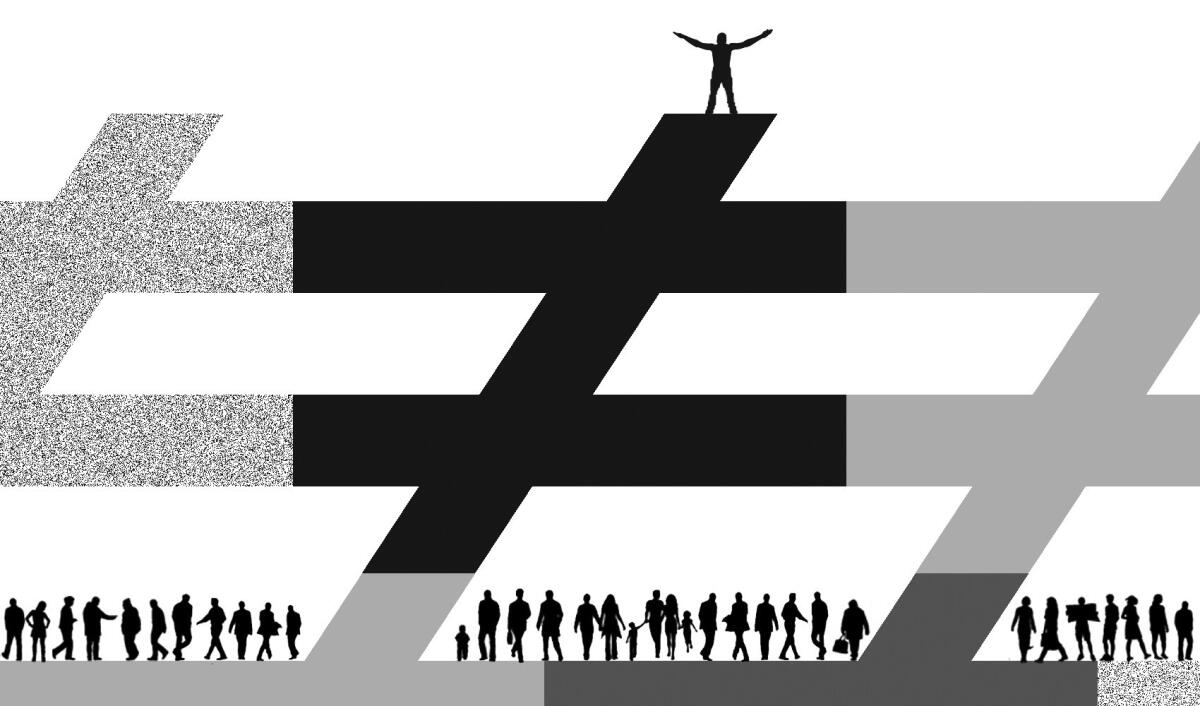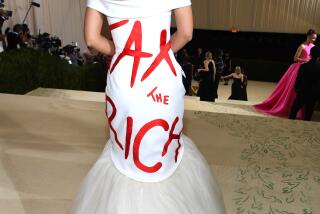Op-Ed: If Democrats really want to address inequality, they need new ideas

The Democrats have a couple of problems when it comes to addressing inequality. First, polling by the White House that was leaked last week apparently found that Americans aren’t much interested in class conflict and punishing the rich. They simply want everyone to do better. And second, even if the party could stir up support for addressing the widening gulf between rich and poor, the time-honored approaches Democrats have relied on in trying to level the playing field just aren’t up to the task. The inequality chasm has grown too deep and too wide to be addressed meaningfully solely by such things as providing welfare for the very poor, increasing the minimum wage and equalizing wages between women and men — though all of those initiatives are worthy and important.
Developing a Democratic Party perspective that truly addresses inequality will require first understanding its dimensions and then designing solutions that address disparities in both income and accumulated wealth.
Let’s examine income first, since it helps build accumulated wealth. According to the Commerce Department, labor’s share of gross national income has declined from about 67% in the 1980s and ‘90s to about 64% today. While there are different ways to measure the labor share, regional Federal Reserve board economists have reported a consensus on its decline. The Labor Department says the ratio of compensation to output has declined from about 63% in the early ‘80s to about 58% recently. The Congressional Budget Office looks at income tax returns and reports that labor’s share of income fell from 75% in 1979 to 67% in 2007. There is no evidence that this trend will reverse.
In addition, the share of income going to the top is also highly concentrated. According to the U.S. Census, in 2011, the richest 1% received almost 47% of all income, the largest percentage since 1917.
Conservatives have fairly raised objections that statements about the concentration of income at the top ignore transfer payments such as Social Security, welfare and food stamps to the poorest Americans, and do not include the greater portion of taxes paid by the more well-off. But a fine-grained analysis by the Congressional Budget Office taking those factors into account still found that the incomes of the richest 1% of households grew at more than 15 times the rate of those in the poorest 20% of households between 1979 and 2007.
When we look at the concentration of accumulated wealth, the disparity becomes even more acute. The wealthiest 10% of Americans control more than three-quarters of all U.S. wealth and 80% of all financial assets. Again, there is no evidence that this trend will reverse. The number of citizens owning shares in the stock market is dropping, and the vast majority of mutual funds are held by the wealthiest households.
The poor, by contrast, have few assets other than their cars and, if they are old enough or disabled, their Social Security benefits. They generally have no 401(k) plans or have little money in them. And the concentration of capital ownership compounds, since those who own it reap capital income going into the future.
Recently, the Urban Institute and the Brookings Institution Tax Policy Center reported that the richest 20% of the U.S. population received 86% of all capital gains and capital income such as dividends and interest.
A crucial component of addressing the inequality dilemma must be broadening access for the middle class to capital and capital income, something the traditional Democratic policies simply haven’t addressed.
How might Democrats go about promoting capital ownership and income? They should start by looking to companies that give their middle-class employees access to capital by sharing profits and ownership shares, on top of good wages — multinational corporations like Google and Microsoft and Qualcomm; small businesses with employee stock-ownership plans like W.L. Gore; manufacturing behemoths like Procter & Gamble; and a slew of other firms. Democrats should then look to restructuring the tax code in ways that encourage a broader range of companies to embrace low-risk profit-sharing and employee ownership programs, perhaps even making such programs a condition for receiving federal corporate tax deductions.
They should also look for opportunities to form more private-public ventures such as the Alaska Permanent Fund, which invests money received from leasing oil fields on public lands to major oil companies and then pays dividends to Alaska residents.
Such approaches are necessary to avoid a future in which capital continues to concentrate, which could mean that a small group will own most of future technology. Ownership of future technology and the income from it needs to be broadened through a private market economy. On all of these fronts, Democrats need to develop comprehensive and sensible policy initiatives to expand not only income but also capital ownership to the middle class.
Joseph R. Blasi is a business professor at Rutgers and the author (with Richard B. Freeman and Douglas L. Kruse) of “The Citizen’s Share: Reducing Inequality in the 21st Century.”Follow the Opinion section on Twitter: @latimesopinion
More to Read
A cure for the common opinion
Get thought-provoking perspectives with our weekly newsletter.
You may occasionally receive promotional content from the Los Angeles Times.






